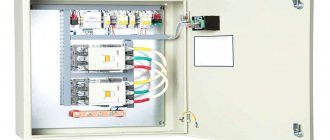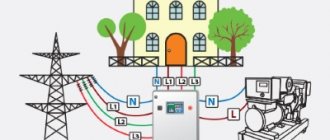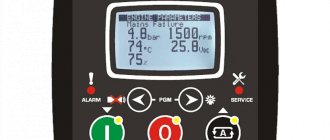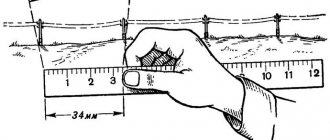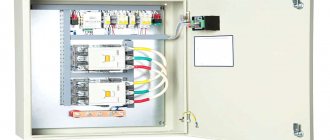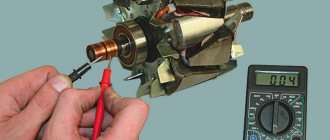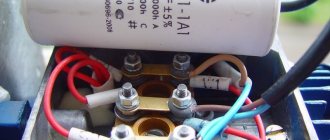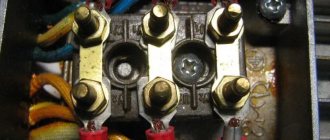One of the most common and used switching devices is changeover switches. They are involved in the creation of many electrical systems. In its essence and design, it is a switch that differs from a simple switch by additional contacts that allow you to switch from one equipment to another, and not just turn it on/off.
Changeover switch
This is especially important when you have to switch high voltage circuits, such as power lines. In this case, you cannot make a mistake and use conventional switches, which the operator may confuse. A switch, in any case, will connect only one of the lines and will not allow an accident.
When you need to not only switch lines, but also turn them off completely, you can use a three-position device with an intermediate position. If we talk about home use, then you can take a changeover type switch to work in the following three fixations:
- home electrical network;
- shutdown;
- Load power supply from generator.
Three-position changeover switch
BUY A SWITCH FOR CONNECTING A GENERATOR
To understand the principle of operation, it is enough to imagine the design of a rocker switch (photo). The vertical position of the handle is the middle contact - off. Lateral position I or II engages only the left or only the right group of contacts. Each of the groups is connected respectively to the generator and the power supply network of the house.
What are the advantages of changeover switches and their disadvantages?
An electric switch is a fairly simple device, but it also has its pros and cons. There are quite a lot of advantages:
- a simple open design or semi-closed, that is, visuality, which allows you to easily find and fix the breakdown;
- easy maintenance and repair;
- ability to work with switching current of 500, 630, 1000 amperes;
- variety of models and wide application;
- availability of a device with high switching power at a low cost, which is a significant advantage.
Open changeover switch
The main disadvantages are:
- available among a wide variety of large number of open designs. Therefore, if you do not use it carefully, you can get under voltage;
- depending on the switching speed and the operator's response. When switching slowly, a high-temperature arc may form and the internal components of the switch may burn out;
- in the occurrence of current surges if switching occurs before the load is turned off;
- in the existing possibility of a short circuit during an arc.
It is better to place such switches in a casing or a closed, secure cabinet.
Organization and device of automated switching
In order not to switch the switch manually in the absence of electrical energy supply, you need to take care of implementing a simple circuit. It will allow you to start a gasoline generator automatically in order to switch from an external network to an autonomous one.
For installation, you will need to purchase two starting devices or contactors. They have cross switching. When they start to work, power and closed contacts are activated. They are required to provide time for the unit to warm up. For this purpose, a relay with a timer is purchased.
When the energy disappears, the power contacts are disconnected. At this time, the closed ones stop touching. Users can independently set the optimal time for the coil to be energized and the backup input to open. After this, the power contacts on the starter, which is intended for backup, are closed. At this time, electric current is supplied from the gasoline generator to the home network.
When the centralized power supply to a private house is resumed, the main starter coil will operate. The power contacts close and the power from the generator is automatically turned off. The home owner must turn off the engine to stop the generation of electrical energy.
Modern changeover switch - connection to a generator
The instability of the supply of electricity to country and country private houses forces owners to acquire an additional power source - a generator. There is a need to change the electricity supply in the house. There is nothing particularly difficult about this. You just need to select a changeover switch, install it in the panel and correctly connect it to the network. Let's look at the important points when installing it, and what the connection diagram is.
What to do during installation - my tips
For household connection of a generator, it is convenient to use an ABB reversible changeover switch . It is compact and safe; it is installed in a regular panel on a DIN rail. This device can be connected to a single-phase as well as a three-phase network, since it is possible to equip it with additional contacts.
For a single-phase network, a 2-pole device is suitable; for a three-phase network, a 4-pole device is suitable, which switches three phases and zero at once from the input power to the generator. The ABB three-pole switch can be useful for both a single-phase network and also for a three-phase network without a neutral wire.
If you plan to place the switchboard indoors, you can use plastic or metal boxes.
A metal shield with a high degree of protection should be installed outdoors. A DIN rail is mounted inside, designed to accommodate all the necessary modules of the circuit. For the safety of using a changeover switch, I recommend taking into account the following points:
- It is better to place the shield indoors;
- operating temperature should be in the range -40 +55°C;
- it is necessary to protect devices from moisture;
- the switch module must be firmly and securely installed and secured;
- when installed outside the home, provide protection from weather influences;
- all actions with the switch - installation work, repairs, maintenance should be carried out when the network is completely disconnected.
Three-phase network
The switch must be mounted using power supplies with voltage parameters of 400 V. The transformers that are used are pulsed. To connect, you need to provide an inverting input. The output current flows through the transition capacitor elements. The use of two-module types of reversible switch is required.
Single-module models are characterized by a maximum voltage limit of 350 V. The negative resistance is 55 Ohms. A blocker is required. Electrical panels are required in residential buildings. The preferred modification is KK22. In control units they are installed as thyristors, and options with dinistors are also acceptable.
Connection diagrams
The ABB changeover switch for domestic use consists of two identical load switches. They are connected to each other and a switch with three positions is installed on top. In position I, switching occurs with the main supply network, all circuits are open - in the middle position, position II - a replacement power source is connected - a generator. The closed design of the ABB reversing switch makes switching safe and can be done even by an untrained user.
So, to connect the generator, you need to connect the main network cable to one input group of the switch, and the cable from the generator to the second. The ABB modular switch has two inputs and outputs. To connect the outputs to the load, they are connected to each other by jumpers in parallel.
For a three-phase connection, one more contact must be connected to the switch body on the right and left. It is important to remember that the reversing switch does not provide releases, neither thermal nor electromagnetic, but only the load switch principle works. Therefore, circuit breakers are installed at the input from the power supply network and the generator. Their maximum current is determined by the permissible load on the supply line.
Connection via a three-position switch. 1 - input circuit breaker, 2 - meter, 3 - RCD, 4 - generator, 5 - three-position switch, 6 - zero bus N, 7 - grounding bus PE, 8 - to consumers
The machine for the electrical network is usually located in the electricity metering panel. The input from the generator must also be protected by an automatic circuit breaker, which is mounted in the switch panel and located next to it. During installation, observe the polarity, otherwise it may happen that the zero and phase at the output change places. Automatic switches are necessary in this scheme: a changeover switch does not protect the network from overloads and short circuits.
A changeover switch is an excellent solution for safely and error-free load transfer from one supply line to another. This is a modern device, characterized by reliable contact insulation, the presence of an arc extinguishing device in many modifications, and an indication of the current position of the switch.
Reversing switches from the Finnish company ABB, designed for rated current from 25 to 100A, voltage 230/400V, are presented in our online store of building materials “Kuzmich24” in a large assortment. In any situation - during quiet work or during an accident on the main line - such a device will provide you with an uninterrupted supply of electricity to your home.
Your Kuzmich.
Switch design
Installation of a reversing circuit breaker in a distribution panel
The reversing circuit breaker has the form of a box with a blade built-in contact system and spring brackets. When closing the first, metal blades enter the brackets. Thanks to this operating principle, contact rupture under its own weight is eliminated. There is a smooth redistribution of electricity from one line to another.
You can fix the switch on the wall in any position - horizontally, vertically and even diagonally. This does not affect its performance.
Generator, electrical network and automatic heating boiler
A standard generator, designed according to the classical scheme, produces a sawtooth sine wave of the mains voltage, so it is advisable to use an inverter generator for a heating boiler that produces voltage in the form of a pure sine wave (wave). The frequency from a conventional generator is generated with a value different from the industrial frequency of the alternating voltage network of 50 Hz. The voltage is also different from the standard 220V voltage. And many, for example, gas heating boilers require voltage with a clearly defined neutral and phase, while in conventional generators there is no clear phase.
To ensure a high-quality connection of the heating boiler from the generator, it is necessary to use a UPS, and it is better if it has a double converter. It is possible to install a power source with built-in batteries or an accumulator, in which case the UPS will act as an AC converter, which will allow the user to gain a few minutes to start the generator and maintain continuous operation of the heating boiler. The same generator can be used as a battery charger.
The boiler and the circulation pump, its presence in the heating network is necessary, will not fail after power is supplied from the generator, but this probability is nevertheless present, it always increases with periodic use of the generator to power the boiler.
Fig. No. 3. Connection diagram of a heating gas boiler from a generator via a UPS.
An ideal option for an on-line type UPS. Its advantages:
- Voltage to the heating system will be supplied continuously.
- The heating boiler has a clearly marked neutral and phase, this is necessary for boilers with a combustion sensor.
- The voltage sine wave has a pure appearance.
- Excellent network voltage stabilization, the UPS copes with the task of protecting against high-frequency pulses and interference from welding equipment.
- Ability to cope with increased quality of mains voltage without a voltage stabilizer.
- Increasing battery life up to several days, especially if you install high-capacity batteries.
Safety rules required to be followed when operating a generator feeding a heating boiler.
What does a pass-through switch look like and work?
If we talk about the front side, the only difference is: a barely noticeable arrow on the up and down key.
What does a single-key pass-through switch look like? You see there are double arrows
If we talk about the electrical circuit, everything is also simple: in ordinary switches there are only two contacts, in pass-through switches (also called changeover contacts) there are three contacts, two of which are common. There are always two or more such devices in the circuit, and they are switched using these common wires.
The difference is in the number of contacts
The operating principle is simple. By changing the position of the key, the input is connected to one of the outputs. That is, these devices have only two working positions:
- input connected to output 1;
- input is connected to output 2.
There are no other intermediate provisions. Thanks to this, everything works. Because the contact switches from one position to another, electricians believe it is more correct to call them “switches.” So a pass-through switch is also this device.
In order not to rely on the presence or absence of arrows on the keys, you need to inspect the contact part. Branded products should have a diagram on them that allows you to understand what type of equipment you have in your hands. It is definitely found on products from Lezard, Legrand, and Viko. They are often absent on Chinese copies.
This is what the changeover switch looks like from the rear
If there is no such diagram, look at the terminals (copper contacts in the holes): there should be three of them. But not always on inexpensive copies the terminal that stands alone is the input. They are often confused. To find where the common contact is located, you need to ring the contacts with each other at different key positions. This must be done, otherwise nothing will work, and the device itself may burn out.
You will need a tester or multimeter. If you have a multimeter, set it to sound mode - it beeps when there is contact. If you have a pointer tester, ring for a short circuit. Place the probe on one of the contacts, find which of the two it rings with (the device beeps or the arrow shows a short circuit - it deviates to the right all the way). Without changing the position of the probes, change the position of the key. If the short circuit is missing, one of these two is common. Now all that remains is to check which one. Without switching the key, move one of the probes to another contact. If there is a short circuit, then the contact from which the probe was not moved is the common one (this is the input).
It may become clearer if you watch a video on how to find the input (common contact) for a pass-through switch.
Application of ABP
The autostart system is more expensive than the manual one, but it constantly monitors the network voltage. When the voltage disappears, the contactor interrupts the connection between the ATS and the central power grid. The starter turns on and the generator starts working. Most generator owners prefer using cheaper partial automation, which works as follows:
- The main power supply is connected through a contactor that opens when the input is disconnected.
- The gas generator is started manually. A time relay is installed in it to warm up the engine and automatically switch to connecting the reserve to the home network.
- When the power supply is restored, the contactor is switched off and the load is supplied again from the public network.
A fully automated power supply system regulates the operation of the gas generator using microprocessors. Video on this topic
How to connect a pass-through switch
A. Zemskov has a whole video about this. Not to say that it is ideal, but on the whole it leaves a feeling of complete understanding of the topic within the framework of the material taught by the author. Yes, of course, there were those who made rude remarks like that such things are called switches because they throw the ends of the chains crosswise. But we and our readers understand that all this is out of envy. Everyone wants to see a good renovation in their home, but not everyone can pay for it as much as Project-Service charges. This is where the misunderstanding comes from. As for A. Zemskov himself, in our humble opinion, the little man who managed to earn such a car legally is worthy of all respect. So, today we are talking about how to connect a pass-through switch.
Pass-through switches always work in pairs
Now take a look at the third option, which shows how pass-through switches should actually be used
Please note that there are two wires between the control points. And this is a big minus for those who hoped to somehow use old veins lying in the thickness of the walls for control.
Look, now you can see that the neutral (black wire) goes straight to the chandelier. But the neutral can be broken or connected at any time from both ends of the corridor. In this case, there is always a phase on one of the wires, and you just need to apply it to the desired point. Due to this, the whole problem is solved.
Now we leave the bedroom, turn on the light, get to the threshold of the kitchen, and turn off the chandelier. By the way, if someone wants to join night gatherings, they will solve their problems in exactly the same manner without any difficulty. But what if we need to place another switch - say - near the front door?
